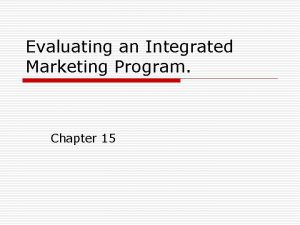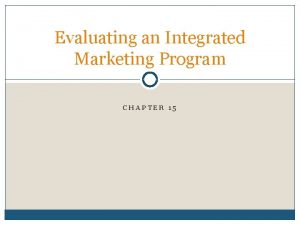Fundamental Issues for Evaluating Program Implementation A Decision












- Slides: 12

Fundamental Issues for Evaluating Program Implementation: A Decision Framework Robert Owens, MA LPRC Learning & Performance Research Center

Purpose and Overview • Purpose: Present fundamental issues in a decision framework • Importance of Implementation Assessment • Fundamental Issues: Decisions • • • Theoretical approach What to measure How to measure Grain size Level of involvement • Complete Framework • Contributions & Limitations

Why Assess Implementation? Implementation Program Outcomes Feedback

Fundamental Issues: Decisions, Decisions • Theoretical Approach – Strict fidelity approach (Mc. Grew et al. , 1994) – Adaptation approach (Castro et al. , 2004) – A little of both? ? (Blakely et al. , 1997; Dusenbury et al. , 2005)

Fundamental Issues: Decisions, Decisions • What to measure – Delivery or Receipt • Orwin’s (2002) distinction – Both are necessary for successful outcomes

Fundamental Issues: Decisions, Decisions • How to measure? (Dane & Schneider, 1998; Dusenbury et al. , 2003) – Quality or how well • Quality-competence or proficiency of delivery • Participant responsiveness-participant engagement – Quantity or how much • Adherence-the degree to which the program is delivered as intended • Dosage-the amount of program activities participants receive

Fundamental Issues: Decisions, Decisions • How to measure? Continued (Chen, 1990) – Structure • Facilitator dimension, Mode of delivery • Participant dimension

Fundamental Issues: Decisions, Decisions • Grain size (Similar to Program Differentiation from Dane & Schneider, 1998; Dusenbury et al. , 2003) – Global implementation • Cantu et al. (2010) – Specific components • Mc. Grew et al. (1994) – How do we divide a program into components?

Fundamental Issues: Decisions, Decisions • Level of involvement – Systematic manipulation • Kumpfer et al. (2002) – Naturalistic observation • (Dusenbury et al. , 2005; Blakely, 1997; Mc. Grew, 1997; and Cantu & Hill, 2010; )

Complete Framework Context of Theoretical Orientation to Fidelity and Adaptation How to measure What to measure Quantity Quality Delivery Adherence Quality Receipt Dosage Participant Responsiveness Structure Facilitator Dimension & Delivery Mode Involvment Systematic Manipulation Participant Dimension Grain Size Global Program Differentiation Specific Components Naturalistic Observation

Contributions & Limitations • Contributions – Clarity on fundamental issues – Guide for practitioners – Especially useful for novices • Limitations – Does not address larger context of implementation – Provides little guidance on actual methods

References • • • Blakely, C. H. , Mayer, J. P. , Gottschalk, R. G. , Schmitt, N. , Davidson, W. , Roitman, D. B. and Emshoff, J. G. (1987) The fidelity–adaptation debate: implications for the implementation of public sector social programs. American Journal of Community Psychology, 15. Cantu, A. , Hill, L. , & Becker, L. (2010). Implementation quality of a family-focused preventive intervention in a community-based dissemination. Journal of Children’s Services, 5(4), 8 -30. Castro, F. G. , Barrera, M. , & Martinez, C. R. (2004). The cultural adaptation of prevention interventions: Resolving tensions between fidelity and fit. Prevention Science, 5(1), 41 - 45. Chen, H. T. (1990). Theory-Driven Evaluations, Sage, London. Dane, A. & Schneider, B. (1998). Program integrity in primary and early secondary prevention: are implementation effects out of control? Clinical Psychology Review, 18. Dusenbury, L. , Brannigan, R. , Falco, M. & Hansen, W. (2003). A review of research on fidelity of implementation: implications for drug abuse prevention in school settings. Health Education Research, 18. Dusenbury, L. , Brannigan, R. , Hansen, W. , Walsh, J. , & Falco, M. (2005). Quality of implementation: developing measures crucial to understanding the diffusion of preventive interventions. Journal of Alcohol and Drug Education, 20. Kumpfer, K. , Alvarado, R. , Smith, P. , Bellamy, N. (2002). Cultural sensitivity and adaption in family-based prevention interventions. Prevention Science 3. Mc. Grew, J. H. , Bond, G. R. , Dietzen, L. and Salyers, M. (1994). Measuring the fidelity of implementation of a mental health program model. Journal of Consulting and Clinical Psychology, 62. Orwin, R. G. (2000) Assessing program fidelity in substance abuse health services research. Addiction, 95.
 Objectives of decision making
Objectives of decision making Investment decision financing decision dividend decision
Investment decision financing decision dividend decision Mis issues in strategy implementation
Mis issues in strategy implementation Staffing follows strategy adalah
Staffing follows strategy adalah Staffing and directing
Staffing and directing Full form of nrnmb is
Full form of nrnmb is Management issues central to strategy implementation
Management issues central to strategy implementation Implementing strategies management and operations issues
Implementing strategies management and operations issues Mis issues in strategy implementation
Mis issues in strategy implementation Strategy implementation example
Strategy implementation example Evaluating an integrated marketing program
Evaluating an integrated marketing program Evaluating an integrated marketing program
Evaluating an integrated marketing program Evaluating an integrated marketing program
Evaluating an integrated marketing program























